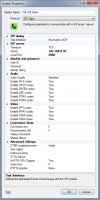User Tools
Sidebar
Navigation
software:gui-designer:system-manager:sip-client
Table of Contents
SIP Client
SIP Client systems are only available in iViewer v6 and guiDesigner v6 or above - These are not currently available for public use.
What is SIP?
SIP is an industry standard protocol for voice and video calling.
iViewer can act as a SIP Client endpoint in a larger SIP network, making and receiving voice and video calls with other endpoints such as phones, intercoms and door stations.
SIP Server
You must have a PBX server/gateway available for communications to work with other SIP clients. There are many free SIP gateways available for running on your own machines, as well as quite a few online hosted solutions you can utilise.
Examples of servers:
Adding SIP Client
 To add a SIP Client to your guiDesigner project, you need to add a new system in the System Manager, and choose the
To add a SIP Client to your guiDesigner project, you need to add a new system in the System Manager, and choose the SIP Client protocol.
System Properties
SIP Dialog
Setting relating to the communication (commands and responses) with the SIP Client system.
SIP Dialog: Text Interface
The SIP Client system type can be controlled via two different protocols:
- Raw Text = Plain text protocol.
- Structured JSON = JavaScript Object Notation strings.
Both protocol options expose the same functionality. If you are using our JavaScript API to send and parse feedback from the SIP Client system, then the simplest approach is to use the JSON protocol option. But if you are wanting to send simple commands directly, then the raw text protocol option might be a better choice for you.
SIP Server
Settings relating to communication with the SIP server.
SIP Server: Transport
Choose the transport to use when communicating with the SIP server. Options are TCP, UDP, TLS (Secure TCP) and DTLS (Secure UDP). Some SIP Servers will only allow one of these transport types, so consult your SIP server documentation for the correct one to use.
SIP Server: Server
Enter the IP address or hostname of the SIP Server that you are using for your SIP network. This could be a local network appliance or software running on a local machine, in which case you would enter the server IP address. Or it could me a remotely managed/hosted service in the cloud, in which case you would most likely enter the service hostname/URL.
SIP Server: Local Port
Enter the port number that the SIP Server is listening on for incoming SIP registrations.
Identity and Presence
Setting relating to the registration/authorisation with the SIP Server.
Identity and Presence: User ID
Enter the User ID that your device running iViewer will use to connect to the SIP Server. This is commonly the Extension number allocated in the SIP Server, or the SIP Alias name.
Identity and Presence: Password
Enter the password associated with the User ID to register/authorise with the SIP Server.
Identity and Presence: Identity String
Optional, and in most cases can be left blank. Only use this if you need to use a registration identity string that differs from the standard sip:<User ID>@<Server>.
Example SIP Module
software/gui-designer/system-manager/sip-client.txt · Last modified: 2019/10/18 05:13 by jarrod
